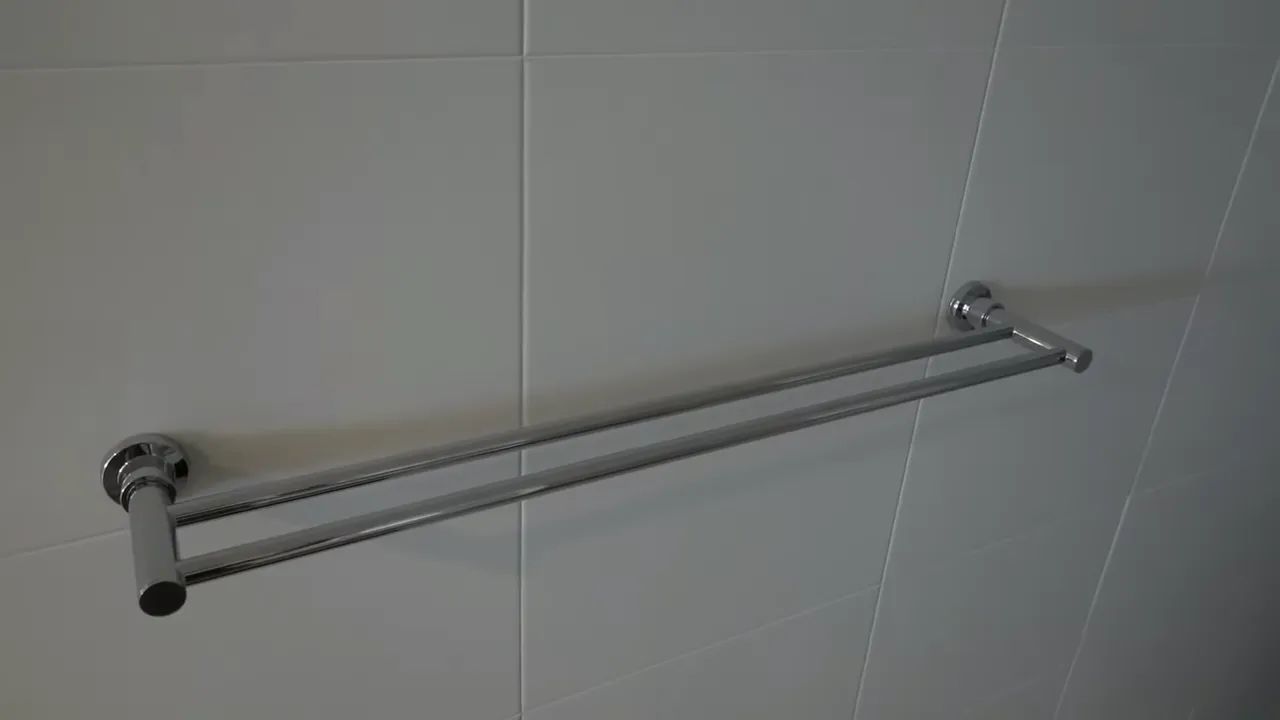To install a towel bar on tile, mark the desired location, drill holes using a masonry bit, insert wall anchors, attach the bar using screws, and tighten securely. Installing a towel bar on tile can be a simple and practical way to add organization and convenience to your bathroom.
Whether you’re looking to update your existing towel bar or starting from scratch, this guide will provide you with the necessary steps to accomplish this task. By following these instructions, you’ll be able to securely install a towel bar on your tile, ensuring it stays in place for years to come.
So let’s dive in and learn how to install a towel bar on tile in just a few easy steps.
Choosing The Right Towel Bar For Tile
When it comes to installing a towel bar on tile, choosing the right one is essential. You want a towel bar that not only enhances the functionality of your bathroom but also complements its overall decor. In this section, we will discuss the key factors to consider when selecting a towel bar for tile installation. By paying attention to the size and weight, style, and mounting system of the towel bar, you can ensure a secure and attractive addition to your bathroom.
Consider the size and weight of the towel bar
Before you begin shopping for a towel bar, it is important to consider the size and weight that will work best for your bathroom. Assess the available space on your tile wall and determine the ideal length and width for the towel bar. Keep in mind that a towel bar that is too long or too wide may overwhelm the space or cause it to sag over time.
Additionally, pay attention to the weight of the towel bar. Heavier towel bars may require a more robust mounting system to ensure stability. A lightweight towel bar, on the other hand, may not require as much structural support.
Select a style that complements your bathroom decor
The towel bar you choose should not only serve its practical purpose but also enhance the aesthetic appeal of your bathroom. Consider the existing style and decor elements in your bathroom and look for a towel bar that complements them. This could include factors such as the finish of the towel bar, the shape of the mounting brackets, or any decorative accents.
Remember, the goal is to create a cohesive and visually pleasing space, so choose a towel bar that seamlessly integrates with your bathroom’s overall style.
Look for a bar with a secure mounting system
When installing a towel bar on tile, it is crucial to choose a bar with a secure mounting system. A flimsy or inadequate mounting system can lead to the towel bar eventually detaching from the wall, causing inconvenience and potential damage.
Look for a towel bar with sturdy mounting brackets that are specifically designed for tile installation. These brackets should provide a strong and reliable grip on the tile to ensure the towel bar stays securely in place.
In addition, consider using anchors and screws that are suitable for tile installation. These specialized hardware options offer enhanced stability and peace of mind.
In conclusion, when selecting a towel bar for tile installation, remember to consider the size and weight of the bar, select a style that complements your bathroom decor, and look for a bar with a secure mounting system. By following these guidelines, you can choose a towel bar that not only enhances the functionality of your bathroom but also adds a touch of style and elegance.
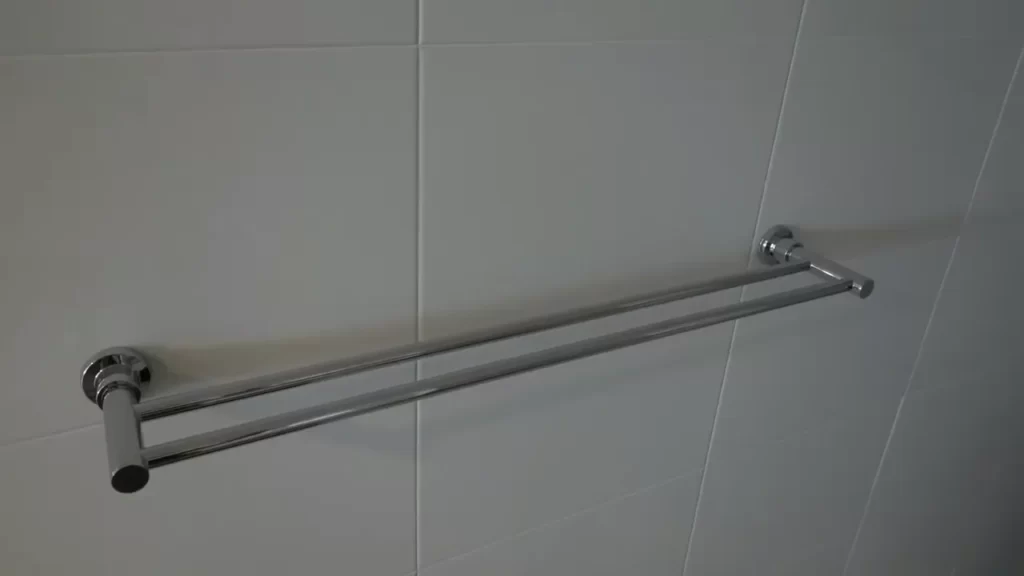
Preparing The Tile Surface For Installation
Clean the tile surface thoroughly
Cleaning the tile surface before installing a towel bar is crucial for proper adhesion. Start by wiping down the tiles with a mild detergent or tile cleaner, using a soft cloth or sponge. Make sure to remove any dirt, grime, or residue that may prevent the towel bar from bonding securely to the surface. After cleaning, rinse the tiles with water and dry them thoroughly with a clean towel.
Measure and mark the desired location for the towel bar
The next step is to measure and mark the location where you want to install the towel bar. Using a tape measure, determine the desired height and position of the bar. Consider the practicality and convenience of the placement, as well as the overall aesthetics of the space. Once you have decided on the location, use a pencil or a marker to mark the exact spots where the mounting brackets will be attached.
Use a level to ensure the bar will be straight
Ensuring that the towel bar is straight is essential for both functionality and visual appeal. To achieve a level installation, use a level tool to double-check the alignment. Place the level on top of the marked spots where the mounting brackets will be placed. Adjust the position as needed until the level indicates that it is perfectly horizontal. This step will help prevent any tilting or slanted appearance of the towel bar once it is installed.
By following these steps and properly preparing the tile surface, you can ensure a secure and professional installation of a towel bar. Taking the time to clean the tiles, measure and mark the desired location, and use a level to achieve a straight placement will result in a towel bar that not only serves its purpose but also enhances the overall look of your bathroom.
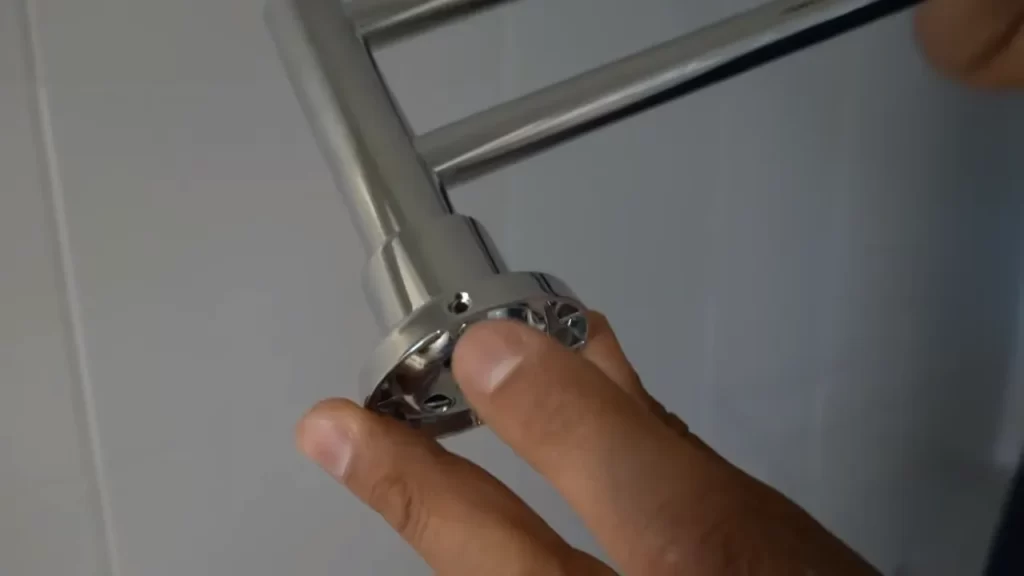
Gathering The Necessary Tools And Materials
Before you begin installing a towel bar on tile, it’s important to gather all the necessary tools and materials. This will save you time and frustration during the installation process. In this section, we will list and describe the tools needed for the installation, identify the materials required, such as screws and anchors, and explain the importance of having everything ready before starting.
List and describe the tools needed for the installation
To successfully install a towel bar on tile, you will need the following tools:
- Power drill: A power drill will make it easier to create the necessary holes in the tile. Make sure you have the appropriate drill bit for your tile material.
- Masking tape: This will help prevent the drill bit from slipping on the tile surface, ensuring precise drilling.
- Tape measure: Use a tape measure to determine the desired location and spacing for your towel bar.
- Pencil or marker: Markings made with a pencil or marker will help you accurately drill the holes and align the towel bar.
- Screwdriver: A screwdriver will be needed to tighten the screws that secure the towel bar to the wall.
- Level: Use a level to ensure the towel bar is installed straight and even.
- Towel bar template or mounting bracket: Some towel bars come with a template or mounting bracket to assist with installation. Check the packaging to see if one is included.
Identify the materials required, such as screws and anchors
In addition to the tools mentioned above, you will need the following materials for the installation:
- Towel bar: Choose a towel bar that matches your bathroom decor and fits the available space.
- Screws: Depending on the towel bar model, screws may be included or you may need to purchase them separately. Make sure the screws are long enough to securely attach the towel bar to the wall.
- Anchors: If you are installing the towel bar on drywall or a hollow wall, anchors will provide additional support. Select anchors that are appropriate for the weight of the towel bar.
Explain the importance of having everything ready before starting
Having everything ready before starting the installation is crucial for a smooth and efficient process. It eliminates the need to pause and search for tools or materials, reducing the risk of damaging the tile or losing momentum. By ensuring you have all the necessary tools and materials on hand, you can focus on the installation itself, resulting in a professional-looking towel bar that securely holds your towels.
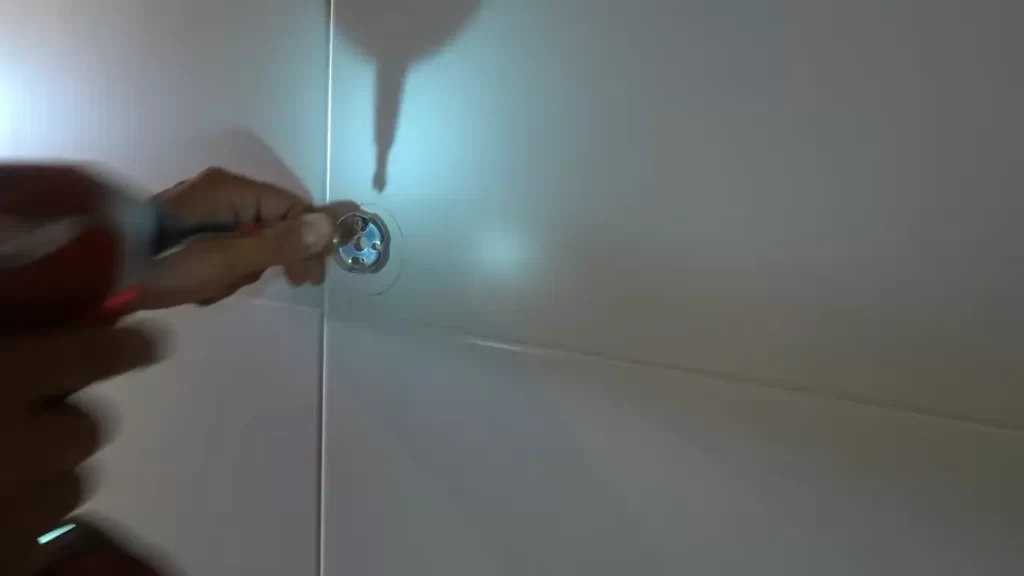
Drilling Holes In The Tile
Discuss the importance of using the right drill bit and technique
When it comes to installing a towel bar on tile, understanding the importance of using the right drill bit and technique is crucial. By using the wrong drill bit or applying incorrect drilling techniques, you risk damaging the tile surface. This can not only ruin the appearance of your bathroom but also compromise the structure of the tile itself. To ensure a successful and damage-free installation, follow the step-by-step instructions provided below.
Provide step-by-step instructions for drilling into the tile
-
Start by gathering the necessary tools and materials. You will need:
- A drill with variable speed
- A suitable drill bit for tile (a carbide-tipped masonry bit is recommended)
- Masking tape or painter’s tape
- A marker or pencil
- A level
-
Identify the exact spot where you want to install the towel bar. Use a level and mark the position with a pencil or marker.
-
Using masking tape or painter’s tape, create an “X” where you want to drill. This helps prevent the drill bit from slipping and provides additional protection for the tile surface.
-
Secure the tile by placing a small piece of scrap wood or a tile spacer beneath it. This will prevent the tile from cracking or chipping while drilling.
-
Select the appropriate drill bit for the tile. A carbide-tipped masonry bit is recommended for drilling into hard tiles such as ceramic or porcelain. Ensure it is the correct size for the anchors or screws you will be using.
-
Fit the drill with the selected drill bit and adjust the drill to a low speed setting.
-
Position the drill bit on the marked spot and hold it perpendicular to the tile surface. Begin drilling slowly, applying gentle pressure.
-
Continue drilling, periodically removing the drill bit from the hole to clear away any debris. This will prevent the bit from becoming clogged and ensure smooth progress.
-
Drill until the desired depth is reached. Take caution not to apply excessive force, as it can lead to tile breakage or cracking.
-
Once the hole is drilled, clean up any remaining debris and remove the masking tape.
Highlight the need for caution to prevent damage to the tile
When drilling into tiles, caution is key to prevent damage. The following tips will help you protect the tile and achieve a successful installation:
-
Apply constant and gentle pressure while drilling. Avoid pushing too hard, as it can cause the tile to crack or chip.
-
Use a low-speed setting on your drill to minimize the risk of tile damage.
-
Wear safety goggles and gloves to protect yourself while drilling.
-
Always double-check the hole location and measurements before drilling to ensure accuracy.
-
If you encounter difficulties while drilling, stop immediately and assess the situation. Applying excessive force or drilling at an angle can lead to tile damage.
By following these instructions and exercising caution, you can successfully drill holes in tile for your towel bar installation without causing damage to the tile surface.
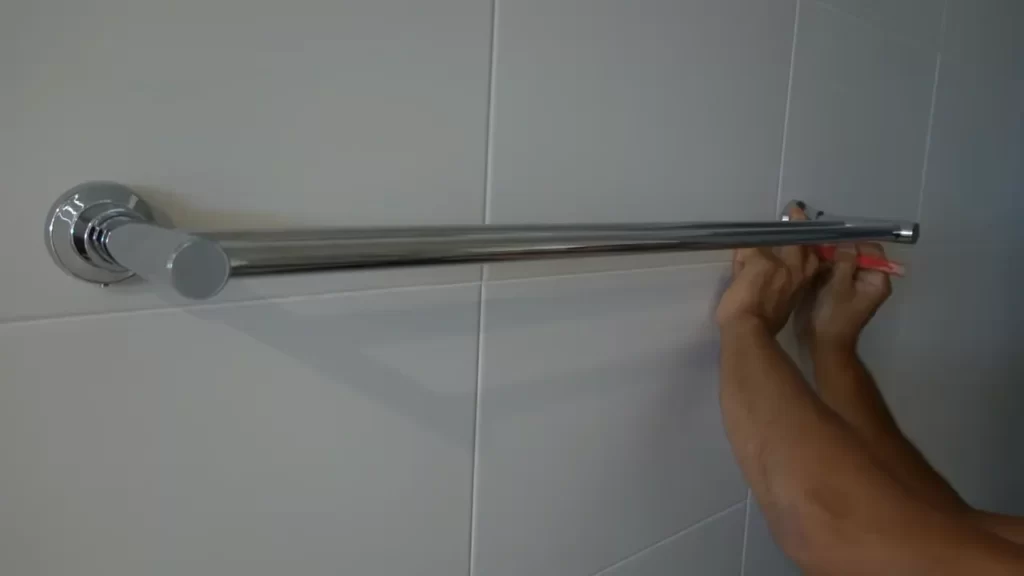
Installing The Mounting Hardware
One of the key steps in installing a towel bar on tile is properly securing the mounting hardware. The mounting hardware serves as the foundation for the towel bar, ensuring its stability and durability. In this section, we will explore the different types of mounting systems available for towel bars, guide you through the installation process for the chosen system, and provide tips for ensuring a secure and long-lasting mount.
Explain the different types of mounting systems for towel bars
When it comes to mounting systems for towel bars, there are several options to choose from:
1. Adhesive Mounting: This type of mounting system involves using adhesive tapes or glue to attach the towel bar to the tile surface. It is a convenient option for those who prefer not to drill into the tile, but it may not be as secure or durable as other mounting systems.
2. Screw Mounting: Screw mounting involves drilling holes into the tile and then securing the towel bar with screws. This system provides a strong and secure hold, but it requires careful measurement, drilling, and screw installation.
3. Toggle Bolt Mounting: Toggle bolts are used for mounting towel bars on tile surfaces when there is no access to the backside of the tile. This method involves drilling larger holes in the tile and inserting toggle bolts to provide a secure hold.
Walk through the installation process for the chosen system
Once you have chosen the mounting system that suits your needs, follow these steps to install the mounting hardware:
Screw Mounting:
- Measure and Mark: Determine the desired height and location of the towel bar and use a pencil to mark the positions where the holes will be drilled.
- Prep the Drill Bit: Attach a suitable drill bit for ceramic or porcelain tile to your power drill.
- Drill Holes: Carefully drill holes at the marked positions, making sure to apply steady pressure and keep the drill level.
- Insert Anchors: Insert plastic or metal anchors into the drilled holes to provide additional support for the screws.
- Attach Mounting Brackets: Align the mounting brackets with the drilled holes and secure them in place using the screws provided.
- Check Alignment: Double-check that the mounting brackets are level and aligned correctly before proceeding.
Toggle Bolt Mounting:
- Measure and Mark: Similar to screw mounting, measure and mark the desired height and location of the towel bar.
- Prep the Drill Bit: Attach a suitable drill bit for tile drilling to your power drill.
- Drill Holes: Carefully drill larger holes at the marked positions to accommodate the toggle bolts.
- Insert Toggle Bolts: Insert the toggle bolts into the drilled holes, making sure the toggles are secured behind the tile surface.
- Attach Mounting Brackets: Align the mounting brackets with the toggle bolts and tighten the screws to secure them in place.
- Check Alignment: Verify that the mounting brackets are level and aligned correctly before proceeding.
Offer tips for ensuring a secure and durable mount
To ensure a secure and durable mount for your towel bar on tile, consider the following tips:
– Use a stud finder or tile mapping to locate any studs or solid backing behind the tile for added support.
– Use a level to ensure that the mounting brackets are perfectly horizontal or vertical, depending on your preference.
– Apply silicone adhesive to the back of the mounting brackets before securing them to the tile for increased stability.
– Use stainless steel screws or bolts to prevent rusting or corrosion over time.
– Avoid overtightening the screws or bolts, as it may lead to cracking or damaging the tile surface.
– Allow sufficient drying or curing time for any adhesive or caulk used during the installation process.
Following these tips and the appropriate installation method for your chosen mounting system will help ensure that your towel bar is securely and durably mounted on the tile surface.
Attaching The Towel Bar To The Mounting Hardware
Once you have successfully installed the mounting brackets for your towel bar on the tile, it’s time to attach the bar itself. This step is crucial in ensuring the stability and functionality of your towel bar. In this section, we will outline the steps for attaching the bar to the mounting brackets, provide guidance on proper alignment and securing, and emphasize the importance of double-checking the stability.
Outline the steps for attaching the bar to the mounting brackets
Attaching the towel bar to the mounting brackets can be done with a few simple steps:
- Start by taking the towel bar and carefully aligning it with the mounting brackets. Ensure that the holes on the bar are lined up with the screws on the brackets.
- Once aligned, insert the screws into the holes on the towel bar and screw them into the mounting brackets. Use a screwdriver or an electric drill with the appropriate attachment to tighten the screws securely.
- Make sure to tighten the screws evenly on both sides to avoid any imbalances or wobbling. This will help maintain the stability of the towel bar.
- Double-check the attachment points to ensure that the towel bar is securely fastened to the mounting brackets. Give it a gentle tug to test its stability.
}
Provide guidance on properly aligning and securing the bar
When aligning and securing the towel bar, pay close attention to the following tips:
- Use a level tool to ensure that the towel bar is straight and properly aligned with your desired position. This will not only provide an aesthetically pleasing look but also prevent any potential issues when hanging towels.
- When securing the screws, be careful not to overtighten them as this could potentially damage the tile or the towel bar. Tighten the screws until they feel snug and secure.
- Consider using anchors if the mounting brackets do not align with existing grout lines on the tile. Anchors will provide additional support and stability for your towel bar.
Emphasize the importance of double-checking the stability
Before considering the installation complete, it’s critical to double-check the stability of the towel bar. This step will help ensure that your towel bar can withstand the weight of towels and daily use without any issues. Pay attention to the following:
- Gently tug on the towel bar from different angles to test its stability. It should not feel loose or wobbly.
- If you notice any instability, recheck the attachment points by loosening and re-tightening the screws. Make sure they are properly aligned and secured.
By following these steps and double-checking the stability of your towel bar, you can enjoy a functional and stylish addition to your bathroom. A securely attached towel bar will provide a convenient place to hang your towels and enhance the overall appearance of your bathroom.
Testing And Finishing Touches
Once you’ve successfully installed a towel bar on your tile, it’s important to perform a few tests to ensure its stability. This will not only guarantee the safety of your towels but also provide a long-lasting solution for your bathroom. In this section, we will outline the importance of testing the towel bar’s stability before use, offer suggestions for adjusting and tightening as needed, and discuss any additional steps or considerations for finishing the installation.
Explain the importance of testing the towel bar’s stability before use
Testing the stability of your newly installed towel bar is crucial to avoid any accidents or damage. Before hanging your towels, it’s essential to put some weight on the bar and ensure it can hold up without any wobbling or shifting. This will help you identify any weak points or areas that require further adjustments. By assessing its stability beforehand, you can prevent the towel bar from falling or loosening later on, providing a reliable solution for your bathroom needs.
Offer suggestions for adjusting and tightening as needed
If you notice any instability during the testing phase, it’s important to address it promptly. Here are a few suggestions for adjusting and tightening your towel bar:
- Double-check the tightness of all the mounting brackets or screws. Sometimes, the bar might become loose due to inadequate tightening. Take a screwdriver and ensure all the connections are secure.
- Consider using wall anchors or toggle bolts if the towel bar appears to be unstable even after tightening the screws. These anchors provide more strength and stability to support the weight of your towels.
- If the towel bar is still wobbly, try adding shims or spacers behind the mounting brackets. These small pieces of material can help fill any gaps or uneven surfaces, providing a stable foundation for your towel bar.
Discuss any additional steps or considerations for finishing the installation
After testing and tightening your towel bar, there are a few additional steps to consider for a polished finish:
- Ensure all the screws and mounting hardware are securely tightened and aligned.
- Double-check the level of the towel bar to ensure it is straight and balanced.
- Wipe down the tile surface with a soft cloth or microfiber towel to remove any fingerprints, smudges, or residues left during the installation process.
- Take a step back and visually inspect the towel bar’s placement and overall appearance. Make any necessary adjustments to achieve the desired aesthetic.
These finishing touches will not only enhance the functionality of your towel bar but also contribute to the overall look and feel of your bathroom space.
Maintenance And Care Tips
Provide tips for cleaning and maintaining the towel bar
Maintaining your towel bar on tile is essential for keeping it in pristine condition and ensuring its longevity. Regular cleaning not only keeps it looking sparkling clean but also prevents the buildup of dirt and grime that can affect its functionality. Here are some tips to help you maintain and care for your towel bar effectively:
- Use a non-abrasive cleaner: When cleaning your towel bar, avoid using harsh chemicals or abrasive cleaners that can scratch the surface of both the bar and the tile. Instead, opt for mild soapy water or a gentle household cleaner to remove any dirt or residue.
- Gently scrub with a soft cloth or sponge: To avoid scratching the surface, use a soft cloth or sponge to gently scrub the towel bar. This will help to remove any stubborn stains or residue without causing damage.
- Dry thoroughly: After cleaning, make sure to dry the towel bar completely to prevent water spots or stains. Use a dry cloth to wipe away any excess moisture and ensure that it is completely dry before hanging any towels.
Offer advice on avoiding damage to the tile surface
Installing a towel bar on tile requires careful attention to avoid damaging the surface. Here are some tips to help you protect your tile while installing and using a towel bar:
- Use the right tools: When installing the towel bar, make sure to use the appropriate tools to prevent any unnecessary damage to the tile. A masonry drill bit and a tile drill guide can help you drill precise holes without causing cracks or chips.
- Apply gentle pressure: While tightening the screws, apply gentle pressure to avoid overtightening, which can crack or damage the tile. Use a screwdriver or wrench instead of a power tool for better control.
- Protect the tile: To protect the tile surface during the installation process, place a piece of cardboard or a soft cloth between the tile and any tools or hardware. This will act as a buffer and help prevent scratches or scuffs.
Suggest regular inspections and tightening of screws
Regular inspections and tightening of screws are crucial for maintaining the stability and functionality of your towel bar. Over time, screws can loosen due to frequent use or vibrations, which may cause the towel bar to become wobbly or even fall off. Here’s what you can do to ensure your towel bar remains secure:
- Inspect periodically: Take a few moments every few months to inspect the towel bar for any signs of looseness or instability. Check if any screws need tightening or if there are any cracks or damage to the tile surface.
- Tighten the screws: Using a screwdriver or wrench, gently tighten any loose screws to ensure the towel bar is securely fastened to the tile. Be careful not to overtighten, as this can damage the thread or the tile.
- Check for possible repairs: If you notice any cracks, chips, or other damage to the tile surface, it’s essential to address them promptly. Repairing or replacing damaged tiles will help maintain the structural integrity of the towel bar installation.
By following these maintenance and care tips, you can ensure that your towel bar remains in excellent condition and your tile stays undamaged. Regular cleaning, gentle handling, and periodic inspections will help you enjoy your towel bar for years to come.
Troubleshooting Common Issues
Even with meticulous planning and careful execution, installing a towel bar on tile can sometimes present its own set of challenges. Certain common issues may arise, such as loose screws or uneven alignment, that require quick resolution to ensure a secure and aesthetically pleasing installation. In this section, we will identify these common problems and offer effective solutions to help you overcome them with ease.
Identify common problems that may arise during towel bar installation
When installing a towel bar on tile, it is crucial to be aware of the potential issues that may arise. By understanding these common problems, you can be better prepared to address them and complete the installation successfully. Below are some common issues you may encounter:
- Loose screws
- Uneven alignment
- Difficulty in finding suitable anchor points
- Tile breakage
- Cracked grout
Offer solutions for issues such as loose screws or uneven alignment
If you find yourself facing problems like loose screws or uneven alignment during towel bar installation, there’s no need to worry. Here are some simple solutions to help you resolve these issues:
- Tighten loose screws: If the screws are not holding the towel bar securely, you can try tightening them using a screwdriver. Be cautious not to overtighten, as this may damage the tile. If the screws continue to loosen, consider replacing them with longer screws or using adhesive anchors for extra support.
- Adjust alignment: In case of uneven alignment, you can make the necessary adjustments by loosening the screws slightly and gently repositioning the towel bar until it is level. Once you have achieved the desired alignment, tighten the screws again to secure the bar in place.
Provide resources or additional guidance for more complex problems
While loose screws and uneven alignment are relatively common issues, more complex problems may occasionally arise during towel bar installation on tile. For such situations, it can be helpful to seek additional guidance or resources. Consider the following options:
| Resources | Description |
|---|---|
| Online tutorials | Search for online tutorials or videos specifically tailored to towel bar installation on tile. These resources often provide step-by-step instructions and troubleshooting tips for various scenarios. |
| Home improvement forums | Join an active home improvement forum where you can ask questions and get advice from experienced DIY enthusiasts or professionals. |
| Consulting professionals | If you encounter complex problems that you are unable to resolve on your own, it may be worth consulting professionals such as plumbers, handymen, or tile installers who can offer expert assistance. |
By utilizing these resources and guidance, you’ll be equipped to tackle even the most challenging towel bar installation issues on tile.
Frequently Asked Questions
What Is The Best Adhesive For Towel Bar On Tile?
A strong adhesive suitable for attaching a towel bar to tile is an epoxy-based adhesive. It provides a secure bond and is resistant to moisture, ensuring long-lasting stability. Be sure to clean the tile surface thoroughly before applying the adhesive for optimal adhesion.
How Do You Secure A Towel Rack To A Tile Wall?
To secure a towel rack to a tile wall, use a drill and wall anchors specifically designed for tile. Mark the desired position, drill pilot holes, insert the anchors, and then screw the towel rack into place. Make sure to use the appropriate tools and follow the manufacturer’s instructions.
How Do You Hang A Towel Bar Without Drilling?
To hang a towel bar without drilling, you can use adhesive mounting strips or suction cups specifically designed for such purposes. These alternatives provide a secure attachment to the wall without damaging the surface. Simply follow the instructions provided to hang your towel bar effortlessly.
How Do You Drill Into Tile For A Towel Rail?
To drill into tile for a towel rail, start by marking the desired location on the tile. Use a masonry drill bit with low speed and gentle pressure to avoid cracking the tile. Secure the rail using appropriate hardware, making sure to use wall anchors if necessary.
Conclusion
Installing a towel bar on tile can seem like a daunting task, but with the right steps, it can be a straightforward process. By following our guide, you can ensure a secure and long-lasting installation. Remember to measure carefully, use the right tools, and follow the manufacturer’s instructions.
With a little patience and attention to detail, you’ll have a perfectly mounted towel bar that adds both functionality and style to your bathroom. Happy DIY-ing!
